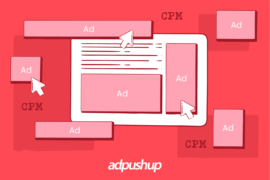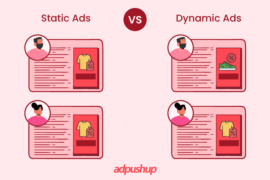Is your revenue graph stuck in a downward trend? Don’t worry, at some point or the other, every publisher faces this problem. It’s not the end of the world. It just means that you need to buckle down, reevaluate your content and ad strategy, eliminate things that aren’t working, and do more of what is.
Here are some common problems that may be causing a dip in your ad revenue along with ideas on how you can fix them.
1. Your Ad Layout is Poorly Executed
The one thing that can make the difference between the optimum utilization of your ad space and its complete wastage — layout.
Efficient ad layouts improve your website’s user experience and increase your ad revenue; poorly executed layouts, on the other hand, ruin a website’s interface, alienate users, and more often than not lead to low impressions and clickthrough rates.
Selecting an ad layout that works is not as simple as picking the three most popular ad units and hoping it’ll work; what works for someone else’s website may not necessarily work for yours.
There are three primary factors that you need to consider when setting up your ad units: Placement, style, and size.
Ad placement, as the name suggests, refers to where the ad units are placed on your website. In order to nail your ad placement, you need to consider who your users are and where their attention is most likely to be focussed.
Google AdSense has varying ad placement recommendations for news websites, classified websites, gaming websites, forums, blogs, sports websites, and travel websites.
If your website happens to fall into any of those categories, it’s a good idea to follow their placement suggestions.
If not, you’ll need to do your own research and figure out where your users are spending most of their time and place your ad units accordingly — this information can be easily collected with the help of heatmap tools and clicktracking tools.
Also, don’t forget about in-content ads, if your website is content heavy, placing ads in between the content may turn out to be a much more effective rather than the more traditional ad locations such as the header or the sidebar.
After placement comes ad style, i.e., how the ads appear. This layout technique is specific to text ads (border and background colors) since publishers have little or no control over how display ads are served. But it is an important technique nevertheless because text ads need to be an essential part of your ad setup (more on that later).
Here’s the basic idea: You need to select colors that make your ads distinctive without making them seem gaudy or out of place. It’s a fine balance you need to strike. Google AdSense recommends implementing one of the following three ad styles:
To blend, make the background and borders of your ads the same color as the background of your page where the ad is placed. If your site has a white background and you don’t want to spend a lot of time choosing ad colors, we recommend using our pre-designed Google default ad style.
To complement, use colors that already exist on your site, but don’t match the background and borders exactly where the ads are placed.
To contrast, choose colors that stand out against the background of your site. Contrasting is recommended only for sites with dark background, so we suggest using an ad style with white background, white borders, and blue titles.
Finally, on to the subject of ad sizes. Unfortunately there’s no magic size that outperforms all others, but here are a few general guidelines you can’t go wrong with:
- Wider ad units typically outperform taller ad units, this is because readers absorb information in “thought units,” several words at a time.
- There’s an advantage to opting for bigger ad sizes such as 970 x 250 Billboard and the 300 x 1050 Portrait, which is that in a larger frame, both small and large creatives can compete for space, therefore increasing your revenue potential
- Google AdSense recommends a list of top performing ad units that publishers should test individually and decide which units work best for them
2. You Haven’t Optimized Your Ad Setup
Besides planning and executing a good ad layout and testing your ads, there are many other little things (call them “hacks” if you will) that can be done to make sure that you’re making the most of your inventory. Here are a few of them:
- Configure your units to display both text and display ads. This increases competition between ads as more number of ads bid for a limited space, consequently also increasing your revenue potential.
- If you typically publish longer posts, enable pagination on your website so that the ads are refreshed each time a user moves on to the next page. This strategy is especially effective if you run CPM ads. Even your readers will thank you for breaking down long posts into smaller, more digestible parts.
- Maximize your ad coverage. Every network has its own rules and stipulations about this. Google AdSense for instance, allows publishers to place three AdSense content units, three AdSense link units, and two AdSense for search units. All three types of ad units have their own pros and cons and you should run them to their full capacity to really make the most of your online real estate. Of course, this shouldn’t be done at the expense of user experience.
- Don’t set too many filters on your ads. While most networks make it easy for publishers to block ads by category, creative, or URL… you shouldn’t go all out in using this feature. This is because each ad you block is one less ad that in the auction, reducing your earning potential.
3. You’re Not Testing Your Ads
Alright. Let’s say you’ve finally got your ad placement, style, and size nailed down. Things seemed to be working fine, or even great, for a while, but now you’re noticing a drop in the revenue. What gives?
Well, one likely reason could be that you stopped experimenting (or never experimented) with your ad setup after the initial setup.
Ad performance is not a constant, it changes over time as users adapt to existing ad locations and begin to tune them out — this phenomenon is called banner blindness.
It’s not just applicable to returning users, even new users may be used to seeing (and mentally tuning out) ads in certain spots on the web page.
Here are a few reasons you need to continuously test ads:
- User interaction with ads changes over time
- If you never test, you would never know if your ad layout is optimal
- Ad testing leads to higher CTR and revenue
- Without testing, you would never be able to identify UX problems
Now that you know why ad testing is important, let’s look at how you can go about doing it. There are two ways to test your ads: Manually and automatically.
Manual testing involves setting up ad variations, comparing results, and then setting up your ad layout based on the data that you’ve collected. You may, for instance, find out that the rectangle ad in between content is doing better than the unit in the sidebar, and change the final configuration accordingly.
AdSense lets you compare ad units by using its “Experimentation” feature. While there’s nothing wrong with manual testing, it can get tedious very quickly and isn’t particularly scalable — it take more time overall to run them and implement changes, not to mention the complexity goes up with each additional variation you want to test.
This is where automated testing comes in. We envisioned and created AdPushup as a tool that helps publishers automate this entire process and run these tests on autopilot based on machine learning algorithms with minimal human intervention.
Once the initial condition is set, our tool automatically starts serving different ad variations, measures the performance for each one of them, and intelligently splits and drives the bulk of the traffic towards the winning variant — ensuring that the publisher’s ad inventory is always in optimum use.
4. Ad Blockers Are Eating Into Your Revenue
Ad blocking has been slowly gaining momentum over the years and its adoption rate in the last few years has been nothing short of alarming. According to a new report from Adobe and PageFair, nearly 200 million users now use ad blockers and $21.8 billion in global ad revenues have been lost to ad blocking so far in 2015 alone.
Here are some statistics from a report by Clarity Rate, based on data collected from over 100 million impressions across several top-tier publishers in the US and Europe:
- On average, 9.26% of impressions were found to be ad-blocked, with some sites reaching as high as 50%
- Tech sites average at 17.79%, followed by news (15.58%) and culture (9.94%). Business, real estate, and travel sites average lower
- Ad-blocking is higher in the US and EU: top countries are Austria (22.50%), Hungary (21.52%) and Germany (19.44%). Average in the US is 8.72%
- The blocking rate is found to be highest among Firefox users (17.81%), followed by Safari (11.30%) and Chrome (10.06%). Explorer averages at 3.86%
- Linux users have a staggering 29.04% blocking rate, compared with 12.95% for Mac users, and 9.25% for Windows users.
- Mobile blocking is gaining popularity: Android shows a 2.24% blocking rate, and iOS 1.33%
- Findings point to the estimation that ad-blocking will significantly increase in consumer adoption
While ad blocking is a convenient solution to a pesky problem (slow, intrusive, bloated ads) for users, it’s also something that threatens the very existence of many publishers.
Fortunately, there are a few things that publishers can do to somewhat minimize the damage done by ad blockers.
Based on browser detection using JavaScript, publishers can identify users that are using ad blockers and request them to whitelist their website, or even redirect them off the page. For more details on how to do this, check out our recent post on how publishers can fight ad blocking.
5. Your Site is Plagued With Low-Quality Content
Last but by no means the least, it’s ultimately the quality of the content on your website that decides the performance of your ads too.
Everything else that you do can only be at best a contributing factor to how well your ads perform in the end; in isolation, none of the tactics mentioned above will work if the foundation is weak.
If you understand your audience and frequently publish high-quality content that resonates with them, higher levels of user engagement is bound to follow as an inevitable consequence. And with that comes more impressions and higher clickthrough rates, it’s a matter of simple mathematics.
Moreover, it’s not only the quantity of audience on your website that matters, it’s the quality of interaction that they have with it.
You can buy traffic in droves if you have the budget but if the content you’re offering is not up to the mark, all that money spent on getting the traffic will come to naught.
After all, they say Content Is King for a reason.

Shubham is a digital marketer with rich experience working in the advertisement technology industry. He has vast experience in the programmatic industry, driving business strategy and scaling functions including but not limited to growth and marketing, Operations, process optimization, and Sales.







